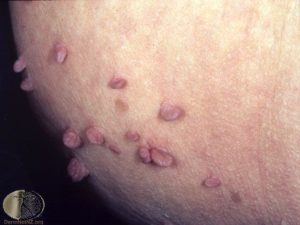
Skin tags are common benign growths on the skin that appear as if they are dangling or hanging off the skin. They develop in both men and women, and more can appear over time. They are typically skin colored but can be darker, and they can range in size from very small (1 mm) to relatively large (5 cm). Skin tags are most often found in skin fold areas and areas of high friction (armpits, neck, groin). Other skin lesions that may resemble a skin tag or have a tag-like shape form can include seborrheic keratoses, molluscum contagiosum, or moles.
Skin tags tend to be more numerous on obese people and in people with type 2 diabetes. It is thought that when people become more resistant to the insulin in their body and they start producing higher levels of insulin, it acts as a growth factor that induces the formation of skin tags. In this setting, numerous skin tags may be found in association with another skin condition called acanthosis nigricans, which causes thickening and darkening of the skin in the armpits, around the neck, and in the groin. If you believe you are suffering from acanthosis nigricans, contact Summit Dermatology to discuss acanthosis nigricans treatment options.
There are several ways to approach skin tag removal. If they are small and numerous, the easiest and most effective way to remove them would be for your dermatologist to freeze them with liquid nitrogen. If there are fewer and if they are slightly larger, snipping them off with scissors is the best treatment option. If a skin tag is very large and has a stalk with a blood vessel inside, electrocautery may be necessary.
If you are interested in skin tag removal options, or treatment for acanthosis nigricans, contact the Board Certified Dermatologists at Summit Dermatology to schedule a consultation at our Colorado Springs or Monument office.
